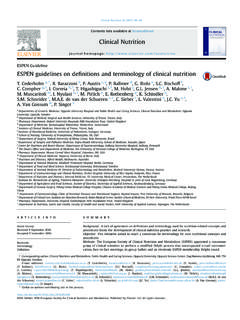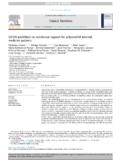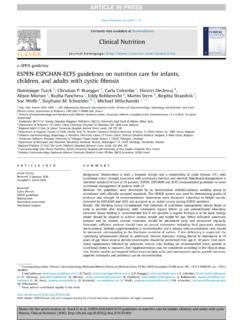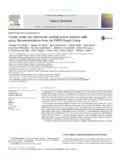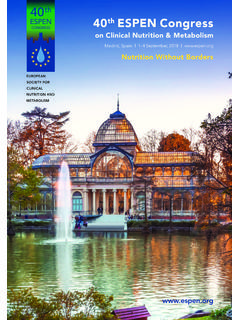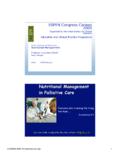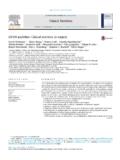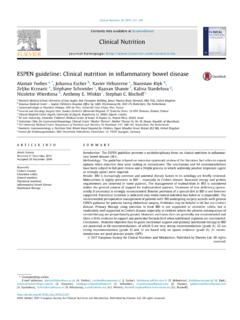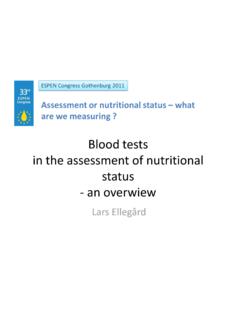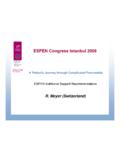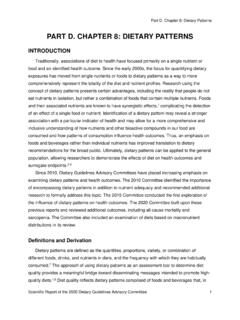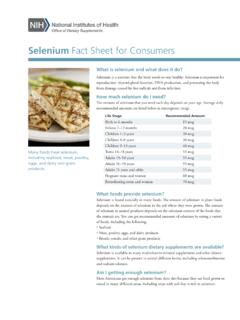Transcription of ESPEN practical guideline: Clinical Nutrition in ...
1 Clinical Nutrition 39 (2020) 632e653. Contents lists available at ScienceDirect Clinical Nutrition journal homepage: ESPEN Guideline ESPEN practical guideline: Clinical Nutrition in in ammatory bowel disease Stephan C. Bischoff a, *, Johanna Escher b, Xavier He buterne c, Stanis aw K e k d, phane Schneider c, Raanan Shamir f, Kalina Stardelova g, Zeljko Krznaric e, Ste Nicolette Wierdsma h, Anthony E. Wiskin i, Alastair Forbes j a University of Hohenheim, Institute of Nutritional Medicine, Stuttgart, Germany b Erasmus Medical Center - Sophia Children's Hospital, Rotterdam, the Netherlands c Gastroent erologie et Nutrition Clinique, CHU de Nice, Universit . e Co^te d'Azur, Nice, France d General and Oncology Surgery Unit, Stanley Dudrick's Memorial Hospital, Krakow, Poland e Clinical Hospital Centre Zagreb, University of Zagreb, Zagreb, Croatia f Tel-Aviv University, Schneider Children's Medical Center of Israel, Petach-Tikva, Israel g University Clinic for Gasrtroenterohepatology, Clinal Centre Mother Therese , Skopje, Macedonia h Amsterdam University Medical Centers, Amsterdam, the Netherlands i Pediatric Gastroenterology & Nutrition Unit, Bristol Royal Hospital for Children, Bristol, United Kingdom j Norwich Medical School, University of East Anglia, Norwich, United Kingdom a r t i c l e i n f o s u m m a r y Article history.
2 The present guideline is the rst of a new series of practical guidelines based on more detailed sci- Received 28 October 2019 enti c guidelines produced by ESPEN during the last few years. The guidelines have been shortened and Accepted 1 November 2019 now include ow charts that connect the individual recommendations to logical care pathways and allow rapid navigation through the guideline. The purpose of the present practical guideline is to provide Keywords: an easy-to-use tool to guide nutritional support and primary nutritional therapy in in ammatory bowel Crohn's disease disease (IBD). The guideline is aimed at professionals working in Clinical practice, either in hospitals or in Ulcerative colitis outpatient medicine, and treating patients with IBD.
3 In 40 recommendations, general aspects of care in Enteral Nutrition Parenteral Nutrition patients with IBD, and speci c aspects during active disease and in remission are addressed. All rec- In ammatory bowel disease ommendations are equipped with evidence grades, consensus rates, short commentaries and links to Nutritional therapy cited literature. 2019 The Author(s). Published by Elsevier Ltd and European Society for Clinical Nutrition and Metabolism. All rights reserved. to the colon and has few direct malabsorptive effects. As in adults, malnutrition is prevalent in paediatric IBD, mainly in active disease and more in CD than in UC. Since patients with IBD constitute a high-risk population for malnutrition, they need screening for 1.
4 Introduction malnutrition, with its subsequent assessment and management. Nutritional care is clearly important in the treatment of patients In ammatory bowel disease (IBD), predominantly ulcerative with IBD and includes prevention of malnutrition and micro- colitis (UC) and Crohn's disease (CD), is now common in the entire nutrient de ciencies, prevention of osteoporosis, and, in children developed world. Malnutrition can occur as well in UC and CD, but promotion of optimal growth and development. is a considerably greater problem in CD given its capacity to affect any part of the gastrointestinal tract, unlike UC, which is restricted 2. Methodology Abbreviations: CD, Crohn's disease; EN, enteral Nutrition ; IBD, in ammatory The present practical guideline consists of 40 recommendations bowel disease; ONS, oral nutritional supplements; PN, parenteral Nutrition ; UC, and is based on the ESPEN Guideline: Clinical Nutrition in in am- ulcerative colitis.
5 * Corresponding author. Institute of Nutritional Medicine, University of Hohen- matory bowel disease [1]. The original guideline was shortened by heim, Fruwirthstr. 12, 70593, Stuttgart, Germany. restricting the commentaries to the gathered evidence and litera- E-mail address: ( Bischoff). ture on which the recommendations are based on. The 0261-5614/ 2019 The Author(s). Published by Elsevier Ltd and European Society for Clinical Nutrition and Metabolism. All rights reserved. Bischoff et al. / Clinical Nutrition 39 (2020) 632e653 633. recommendations were not changed (except arti cial Nutrition Smoking, antibiotic use, and diet are potentially reversible risk was replaced by medical Nutrition and language was adapted to factors for IBD.)
6 Many studies have evaluated the effect of diet on the American English), but the presentation of the content was trans- risk of developing IBD. However most of them are retrospective formed into a graphical presentation consisting of decision-making caseecontrol studies. In 2011 Hou et al. published the rst sys- ow charts wherever possible. The original guideline was developed tematic review entitled dietary Intake and Risk of Developing IBD . according to the standard operating procedure (SOP) for ESPEN [3]. They used guideline-recommended methodology to evaluate guidelines [2]. This SOP is oriented on the methodology of the the association between pre-illness intake of nutrients (fats, car- Scottish Intercollegiate guidelines Network (SIGN).
7 Literature was bohydrates, protein) and food groups (fruits, vegetables, meats) and searched and graded into 1e4 according to evidence, and recom- the risk of subsequent IBD diagnosis. Nineteen studies were mendations were created and graded into four classes (A/B/0/GPP). included, encompassing 2609 IBD patients (1269 with CD and 1340. All recommendations were not only based on evidence, but also with UC), and over 4000 controls. The main results are: (i). underwent a consensus process, which resulted in a percentage of increased risk of developing UC and CD with high intake of PUFAs, agreement (%). Whenever possible, representatives from different n-6 fatty acids, and meats, (ii) decreased risk of CD, but not UC, with professions (physicians, dieticians, nurses, others) as well as patient high intake of dietary ber (>22 g/d) and fruits.
8 Representatives were involved. The guideline process was funded Fiber, fruit and vegetables [4]: Compared to women with the exclusively by the ESPEN society. The guideline shortage and lowest energy-adjusted ber intake, intake of ber in the highest dissemination was funded in part by the UEG society, and also by the quintile (median 24 g/d) was associated with a signi cant reduction ESPEN society. For further details on methodology, see the full in risk of CD [HR , 95% CI ] but not UC. version of the ESPEN guideline [1] and the ESPEN SOP [2]. In a meta-analysis including a total of 14 caseecontrol studies The ESPEN practical guideline Clinical Nutrition in in amma- [5], consumption of vegetables was negatively associated with the tory bowel disease has been structured according to a ow chart risk of UC (OR ), but not with CD (OR ).
9 Higher con- covering all nutritional aspects of IBD (Fig. 1). sumption of fruit was negatively associated with the risk of UC (OR. ) and CD (OR ). 3. Results dietary fat [6]: Cumulative energy-adjusted intake of total fat, saturated fats, unsaturated fats, n-6 and n-3 PUFA were not asso- Prevention of IBD (Fig. 2) ciated with risk of CD or UC. However, greater intake of long-chain n-3 PUFA was associated with a trend towards lower risk of UC (HR. ). In contrast, high long-term intake of trans-unsaturated fatty acids was associated with a trend towards an increased incidence of Recommendation 1. UC (HR ). A diet rich in fruit and vegetables, rich in n-3 fatty acids, and In the EPIC study, 229,702 participants were recruited from nine low in n-6 fatty acids is associated with a decreased risk of European centers between 1991 and 1998 [7].
10 At recruitment, di- developing CD or UC and is therefore recommended. etary intakes of DHA and fatty acids were measured using validated food frequency questionnaires. In a nested caseecontrol analysis, Grade of recommendation 0 e strong consensus (90%. each participant who developed incident UC (n 126) was agreement). matched with four controls. The highest quartile of intake of lino- leic acid was associated with an increased risk of UC (OR ) with a signi cant trend across quartiles (OR per quartile increase). Fig. 1. Structure of the ESPEN practical guideline Clinical Nutrition in in ammatory bowel disease (IBD) . 634 Bischoff et al. / Clinical Nutrition 39 (2020) 632e653. Fig. 2. Prevention of in ammatory bowel disease (IBD; Crohn's disease, CD; ulcerative colitis, UC).
